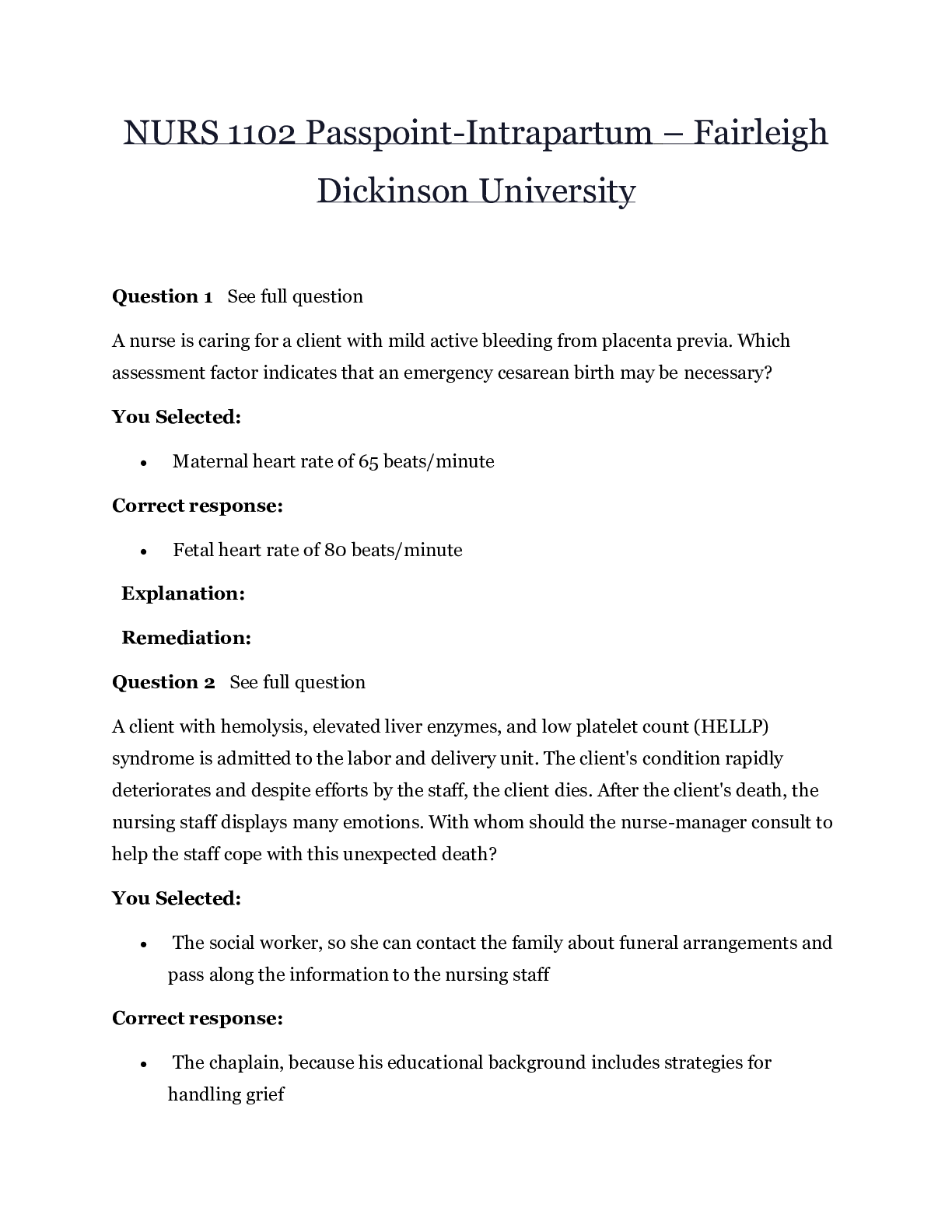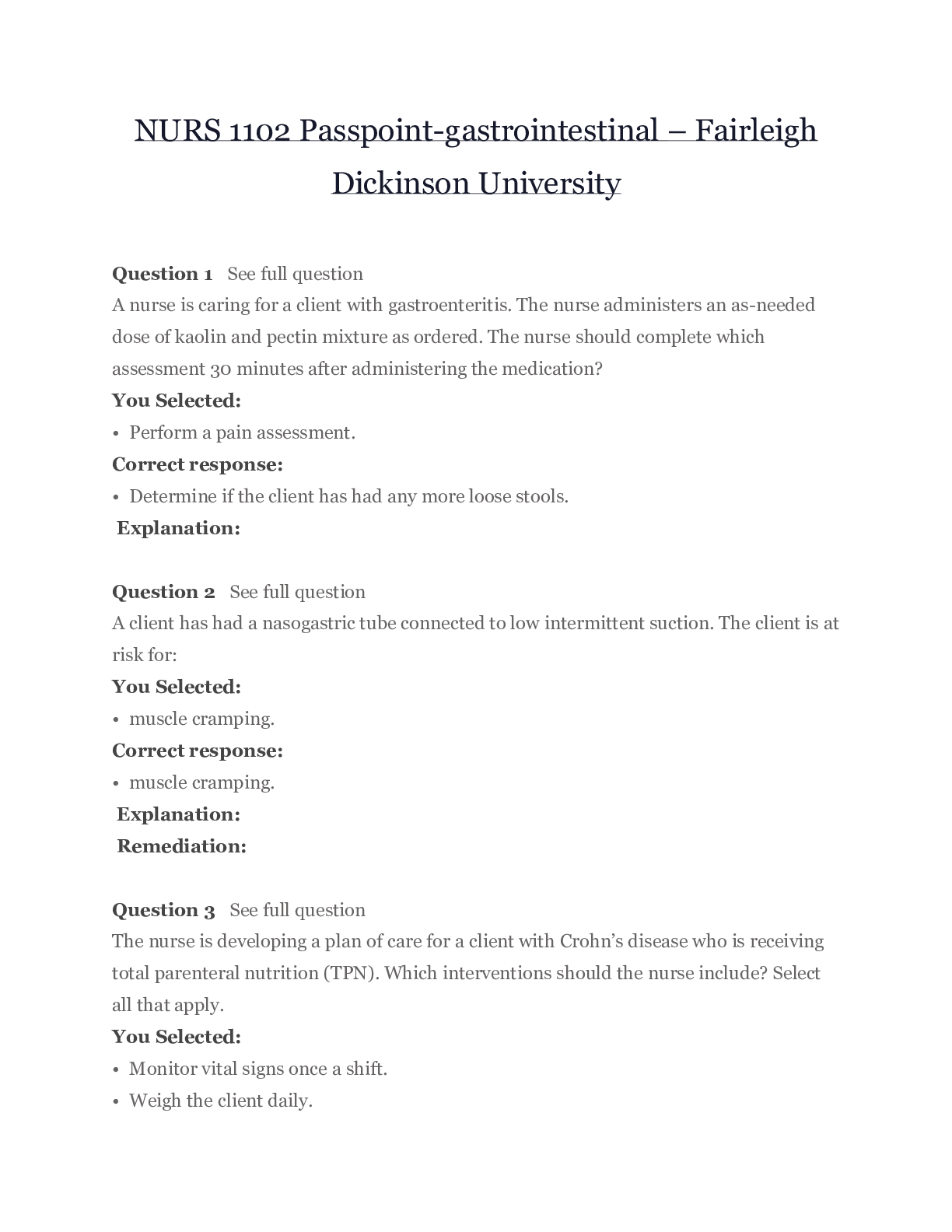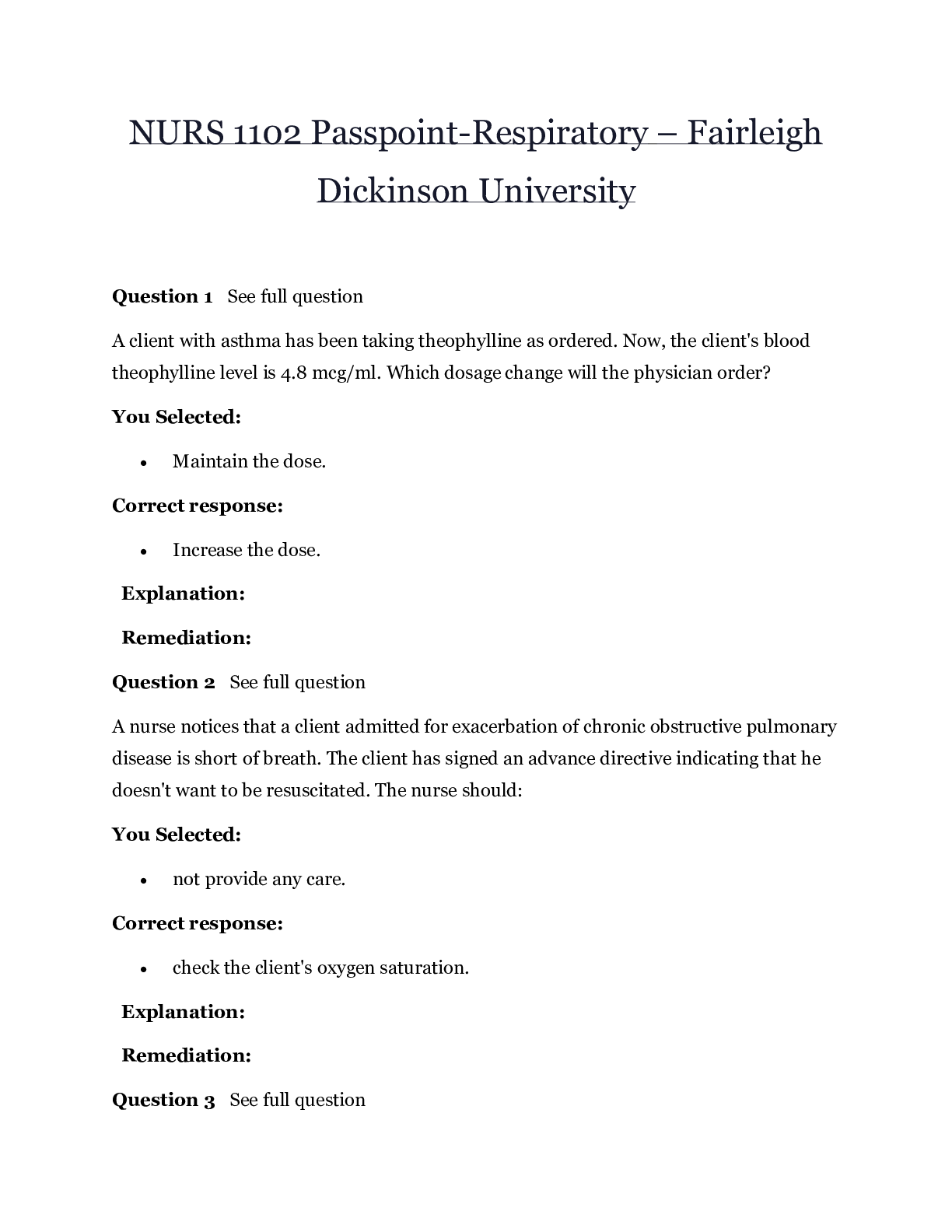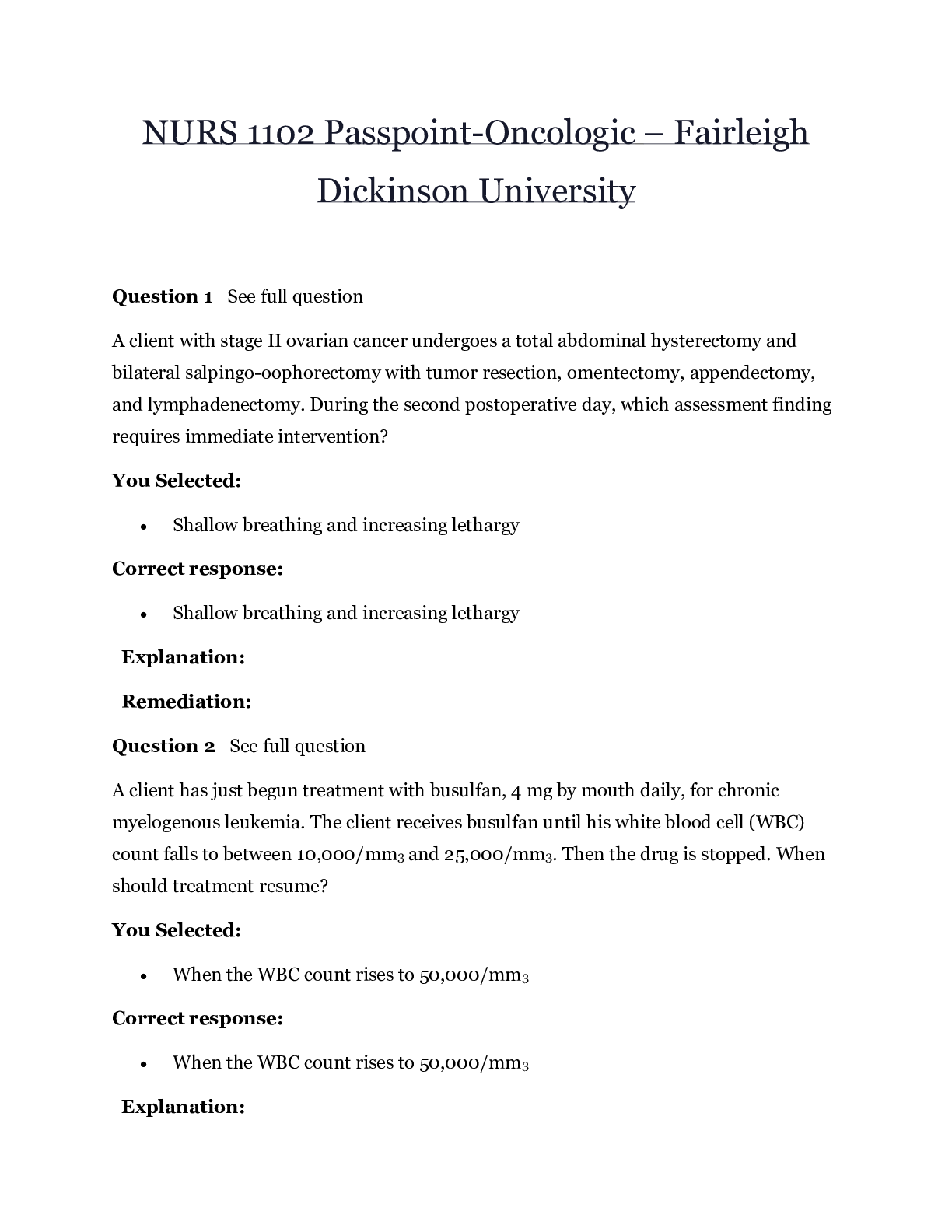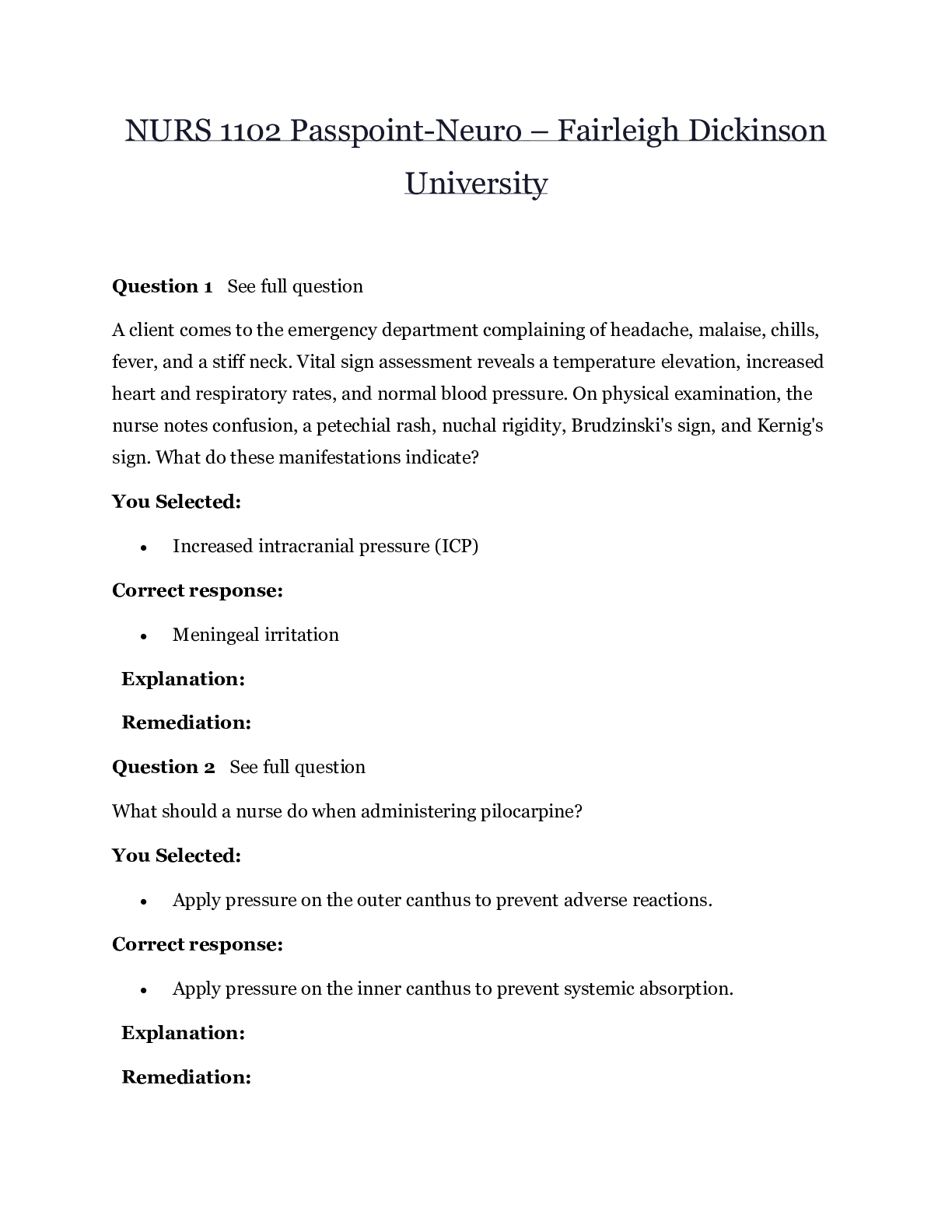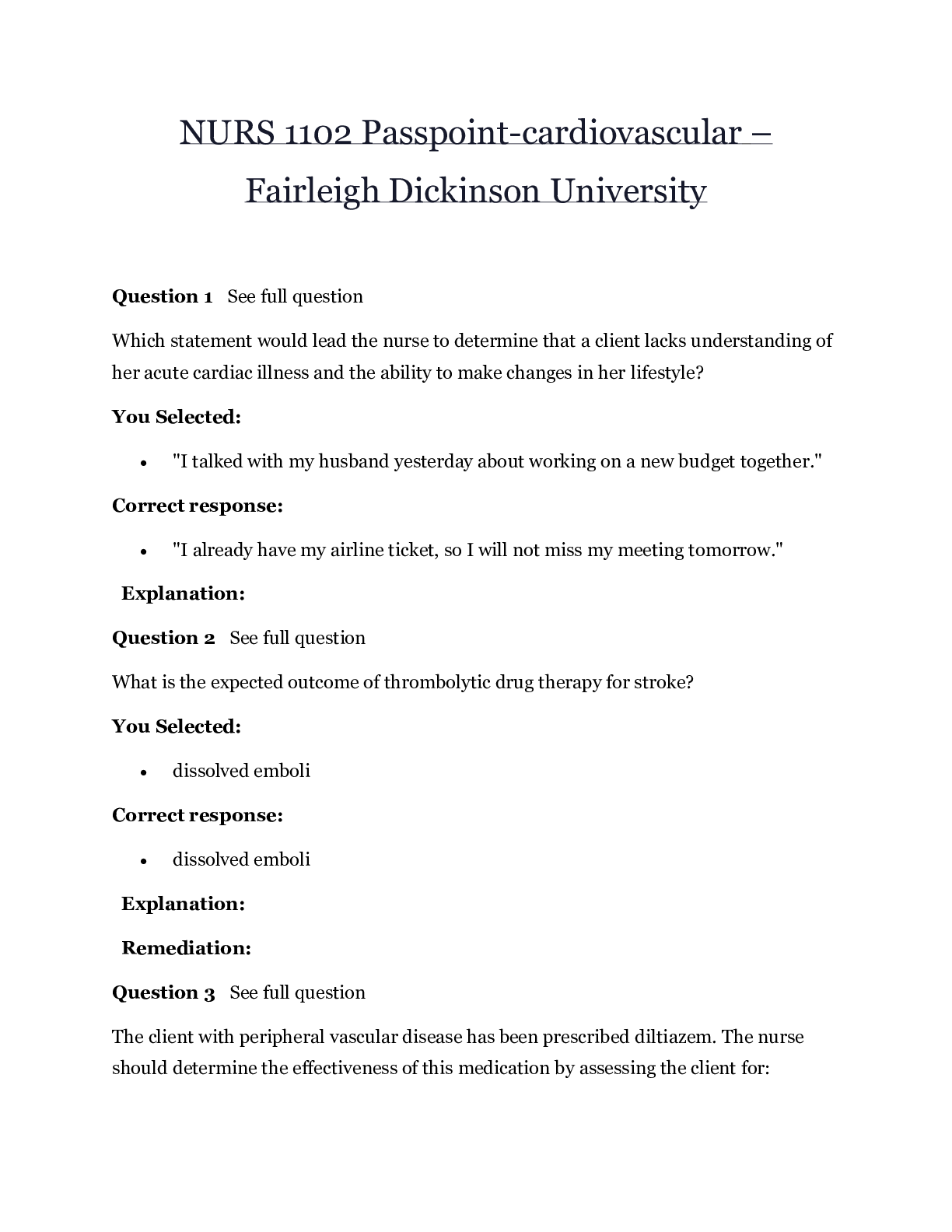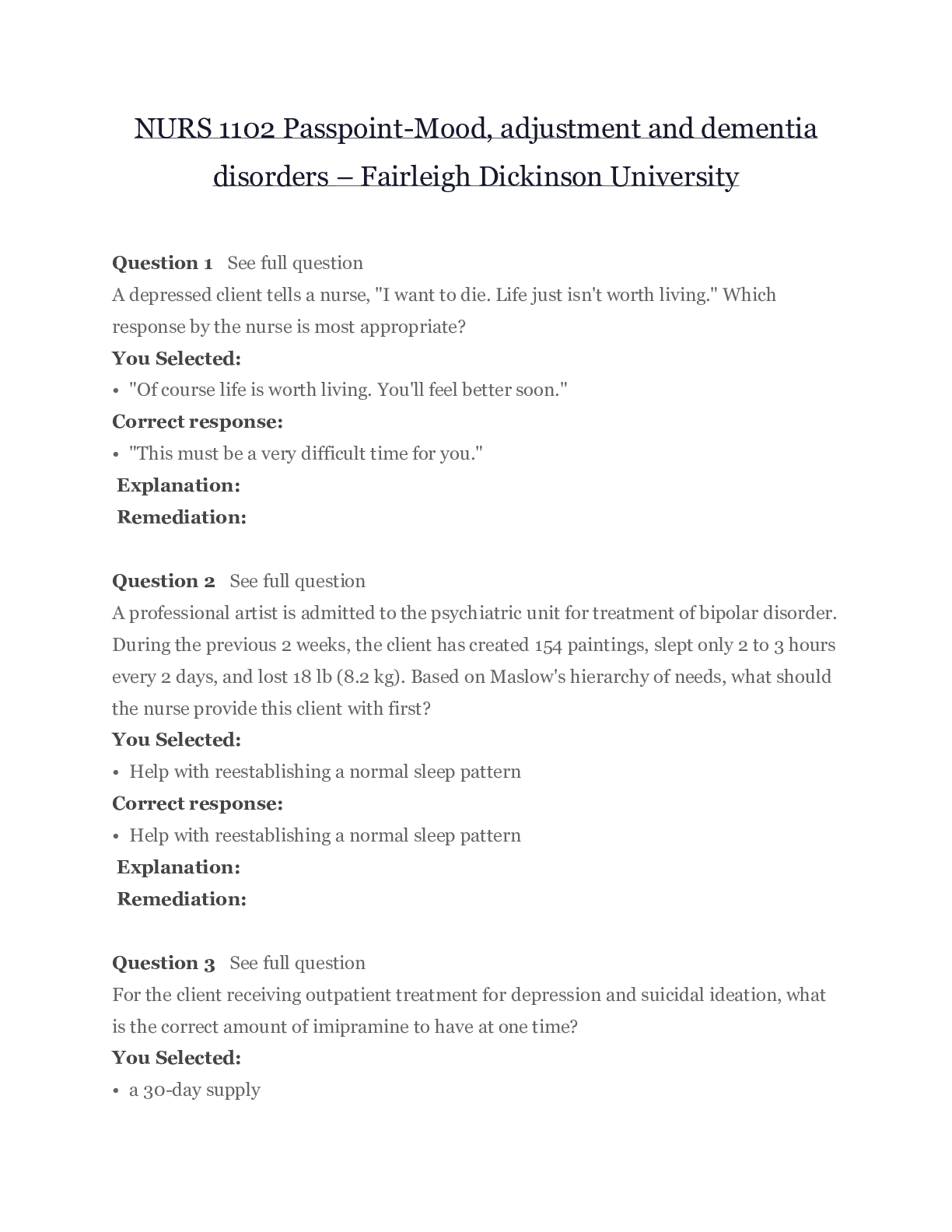*NURSING > EXAM > NURS 1102 Passpoint-Musculoskeletal – Fairleigh Dickinson University | NURS1102 Passpoint-Musculos (All)
NURS 1102 Passpoint-Musculoskeletal – Fairleigh Dickinson University | NURS1102 Passpoint-Musculoskeletal
Document Content and Description Below
NURS 1102 Passpoint-Musculoskeletal – Fairleigh Dickinson University Question 1 See full question A physician orders chlorzoxazone, 500 mg P.O. t.i.d for a client. The nurse knows that chl... orzoxazone, a centrally acting skeletal muscle relaxant, is commonly used to treat: You Selected: • severe muscle spasm. Correct response: • severe muscle spasm. Explanation: Remediation: Question 2 See full question A nurse monitors a client receiving enoxaparin 30 mg subcutaneously b.i.d after hip replacement surgery. Which adverse reaction is the client most likely to experience? You Selected: • Bleeding Correct response: • Bleeding Explanation: Remediation: Question 3 See full question A nurse is caring for a client who complains of lower back pain. Which instruction should the nurse give to the client to prevent back injury? You Selected: • "Narrow the stance when lifting." Correct response: • "Stand close to the object you're lifting." Explanation: Remediation: Question 4 See full question During a scoliosis screening in a college health center, a student asks the public health nurse about the consequences of untreated scoliosis. The nurse indentifies one of the direct complications as: You Selected: • spontaneous spinal cord injury. Correct response: • impingement on pulmonary function. Explanation: Remediation: Question 5 See full question The media requests information from a nurse caring for a client who is a criminal. Which statement best shows the nurse's understanding of confidentiality requirements when the client is a criminal? You Selected: • The nurse shouldn't provide the media with any information about the client. Correct response: • The nurse shouldn't provide the media with any information about the client. Explanation: Question 6 See full question A client has a total hip replacement. Which of the following client statements indicates a need for further teaching before discharge? You Selected: • "I will be careful not to cross my legs." Correct response: • "I can't wait to take a tub bath when I get home." Explanation: Remediation: Question 7 See full question The client sustained an open fracture of the femur from an automobile accident. The nurse should assess the client for which type of shock? You Selected: • cardiogenic Correct response: • hypovolemic Explanation: Remediation: Question 8 See full question A client reports having pain in the casted left arm that is unrelieved by pain medication. The nurse assesses the arm and notes that the fingers are swollen and difficult to separate. What should the nurse do first? You Selected: • Administer morphine 2 mg intravenously. Correct response: • Call the health care provider (HCP) to report swelling and pain. Explanation: Remediation: Question 9 See full question When assessing a client who reports a back injury, it is critical for the nurse to question the client about: You Selected: • family history of back problems. Correct response: • mechanism of injury. Explanation: Remediation: Question 10 See full question The nurse is caring for an elderly client who has hip pain related to rheumatoid arthritis. The client is practicing appropriate self-care activities when the client chooses to sit in which type of chair? You Selected: • curved-back rocking chair Correct response: • straight-back chair with elevated seat Explanation: Remediation: Question 11 See full question The initial postoperative assessment is completed on a client who had an arthroscopy of the knee. Which information is not necessary to obtain every 15 minutes during the first postoperative hour? You Selected: • pain rating of the operative site Correct response: • urine output Explanation: Remediation: Question 12 See full question A client has been positioned in the lithotomy position under general anesthesia for a pelvic procedure. In which anatomic area may the client expect to experience postoperative discomfort? You Selected: • thighs Correct response: • shoulders Explanation: Remediation: Question 13 See full question Which condition should the nurse assess when completing the history and physical examination of a client diagnosed with osteoarthritis? You Selected: • weight loss Correct response: • local joint pain Explanation: Remediation: Question 14 See full question A client who had a total hip replacement 2 days ago has developed an infection with a fever and profuse diaphoresis. The nurse establishes a goal to reduce the fluid deficit. Which outcome is the most appropriate? You Selected: • The client drinks 2000 mL of fluid per day. Correct response: • The client drinks 2000 mL of fluid per day. Explanation: Remediation: Question 15 See full question The nurse is assessing a client’s left leg for neurovascular changes following a total left knee replacement. Which are expected normal findings? Select all that apply. You Selected: • moves toes • pulse on left leg weaker than right leg • pain absent Correct response: • reduced edema of the left knee • skin warm to touch • capillary refill response of less than 3 seconds • moves toes Explanation: Remediation: Question 16 See full question Which client statement identifies a knowledge deficit about cast care? You Selected: • "I can pull out cast padding to scratch inside the cast." Correct response: • "I can pull out cast padding to scratch inside the cast." Explanation: Remediation: Question 17 See full question A client has a left tibial fracture that required casting. Approximately 5 hours later, the client has increasing pain distal to the fracture despite the morphine injection administered 30 minutes previously. Which area should be the nurse's next assessment? You Selected: • vital sign changes Correct response: • distal pulse Explanation: Remediation: Question 18 See full question When caring for a client with acute osteomyelitis in the right tibia, which measure is mostappropriate to implement when repositioning the client’s leg? You Selected: • Hold the leg by the ankle when repositioning to avoid touching the tibia. Correct response: • Support the leg above and below the affected area when positioning. Explanation: Remediation: Question 19 See full question The nurse is planning an educational program about the prevention of osteoporosis for a group of women. Which preventive measures would be appropriate for the nurse to include in the teaching plan? You Selected: • encouraging weight-bearing exercise on a regular basis Correct response: • encouraging weight-bearing exercise on a regular basis Explanation: Remediation: Question 20 See full question The nurse is evaluating the outcome of therapy for a client with osteoarthritis. Which outcome indicates the goals of therapy have been met? You Selected: • joint range of motion improved Correct response: • joint range of motion improved Explanation: Remediation: Question 21 See full question The client returns from surgery for a below-the-knee amputation with the residual limb covered with dressings and a woven elastic bandage. At first, the bandage was dry. Now, 30 minutes later, the nurse notices a small amount of bloody drainage. The nurse should first: You Selected: • mark the area of drainage. Correct response: • mark the area of drainage. Explanation: Remediation: Question 22 See full question What would be the most important nursing intervention in caring for the client’s residual limb during the first 24 hours after amputation of the left leg? You Selected: • Abduct the residual limb on a scheduled basis. Correct response: • Elevate the residual limb on a pillow. Explanation: Remediation: Question 23 See full question Passive range-of-motion (ROM) exercises for the legs and assisted ROM exercises for the arms are part of the care regimen for a client with a spinal cord injury. Which observation by the nurse would indicate a successful outcome of this treatment? You Selected: • absence of tissue ischemia over bony prominences Correct response: • free, easy movement of the joints Explanation: Remediation: Question 24 See full question The nurse is teaching a client with osteoporosis about taking alendronate sodium. The nurse emphasizes that the client is to take the medication: You Selected: • with a full glass of water and remain upright for 30 minutes. Correct response: • with a full glass of water and remain upright for 30 minutes. Explanation: Remediation: Question 25 See full question A client takes prednisone for an acute exacerbation of rheumatoid arthritis. The nurse determines the client understands how to take the prednisone when the client says: You Selected: • ”I can stop taking the prednisone as soon as my joints feel better.” Correct response: • "It is best if I take this medication with some food.” Explanation: Remediation: Question 26 See full question A client comes to the emergency department reporting pain in the right leg. When obtaining the history, the nurse learns that the client has a history of obesity and hypertension. Based on this information the nurse anticipates the client having which musculoskeletal disorder? You Selected: • Muscular dystrophy Correct response: • Degenerative joint disease Explanation: Question 27 See full question A nurse is teaching a client who was recently diagnosed with carpal tunnel syndrome. Which statement should the nurse include? You Selected: • "Surgery is the only sure way to manage this condition." Correct response: • "Ergonomic changes can be incorporated into your workday to reduce stress on your wrist." Explanation: Remediation: Question 28 See full question A client undergoes an arthroscopy at the outpatient clinic. After the procedure, the nurse provides discharge teaching. Which response by the client indicates the need for further teaching? You Selected: • "Elevating my leg will reduce swelling after the procedure." Correct response: • "I should use my heating pad this evening to reduce some of the pain in my knee." Explanation: Remediation: Question 29 See full question A client is brought to the emergency department after injuring his right arm in a bicycle accident. The orthopedic surgeon tells the nurse that the client has a greenstick fracture of the arm. What does this mean? You Selected: • The fracture results from an underlying bone disorder. Correct response: • One side of the bone is broken and the other side is bent. Explanation: Remediation: Question 30 See full question For a client with osteoporosis, the nurse should provide which dietary instruction? You Selected: • "Eat more fruits to increase your potassium intake." Correct response: • "Eat more dairy products to increase your calcium intake." Explanation: Remediation: Question 31 See full question A client with osteoarthritis tells the nurse she is concerned that the disease will prevent her from doing her chores. Which suggestion should the nurse offer? You Selected: • "Do all your chores in the evening, when pain and stiffness are least pronounced." Correct response: • "Pace yourself and rest frequently, especially after activities." Explanation: Remediation: Question 32 See full question A client is admitted with acute osteomyelitis that developed after an open fracture of the right femur. When planning this client's care, the nurse should anticipate which measure? You Selected: • Administering large doses of oral antibiotics as ordered Correct response: • Administering large doses of I.V. antibiotics as ordered Explanation: Remediation: Question 33 See full question Which nursing diagnosis takes highest priority for a client with a compound fracture? You Selected: • Activity intolerance related to weight-bearing limitations Correct response: • Risk for infection related to effects of trauma Explanation: Remediation: Question 34 See full question After a person experiences a closure of the epiphyses, which statement is true? You Selected: • The bone grows in length but not thickness. Correct response: • No further increase in bone length occurs. Explanation: Question 35 See full question Two days after surgery to amputate his left lower leg, a client states that he has pain in the missing extremity. Which action by the nurse is most appropriate? You Selected: • Contact the physician. Correct response: • Administer medication, as ordered, for the reported discomfort. Explanation: Remediation: Question 36 See full question Elderly clients who fall are most at risk for which injuries? You Selected: • Cervical spine fractures Correct response: • Pelvic fractures Explanation: Remediation: Question 37 See full question A client with osteoarthritis asks for information concerning activity and exercise. When assisting the client, which concept should be included? You Selected: • Exercising immediately upon awakening allows the client to participate in activities when he has the greatest amount of energy. Correct response: • Exercising at least 1 hour after awakening allows the client to participate in exercise after some of the morning-related stiffness has subsided. Explanation: Remediation: Question 38 See full question A nurse is managing the care of a client with osteoarthritis. Appropriate treatment strategies for osteoarthritis include: You Selected: • administration of monthly intra-articular injections of corticosteroids. Correct response: • administration of nonsteroidal anti-inflammatory drugs (NSAIDs) and initiation of an exercise program. Explanation: Remediation: - - - - - - - - - - - - - - - - - - - - - - - - - Question 5 See full question A client in the surgical intensive care unit has skeletal tongs in place to stabilize a cervical fracture. Protocol dictates that pin care should be performed each shift. When providing pin care for the client, which finding should the nurse report to the physician? You Selected: • A small amount of yellow drainage at the left pin insertion site Correct response: • A small amount of yellow drainage at the left pin insertion site Explanation: Remediation: Question 6 See full question A client who has skeletal traction to stabilize a fractured femur has not had a bowel movement for 2 days. The nurse should: You Selected: • increase the client’s fluid intake to 3,000 mL/day. Correct response: • increase the client’s fluid intake to 3,000 mL/day. Explanation: Remediation: Question 7 See full question A client who was involved in a motor vehicle accident has a fractured femur. The nurse caring for the client documents "acute pain" as a nursing diagnosis in the care plan. Which nursing interventions are appropriate? Select all that apply. You Selected: • Ask the client about the methods used previously to alleviate pain. • Assess the client's perception of pain. • Tell the client which pain management option to use. Correct response: • Assess the client's perception of pain. • Ask the client about the methods used previously to alleviate pain. Explanation: Remediation: Question 8 See full question A client is experiencing an acute exacerbation of rheumatoid arthritis. What should the nursing priority be? You Selected: • Administering ordered analgesics and monitoring their effects Correct response: • Administering ordered analgesics and monitoring their effects Explanation: Question 9 See full question The nurse enters the room to do an initial assessment on a client with a fracture of the femoral head. What would be the expected findings on the affected limb? You Selected: • Shortening of the affected extremity with external rotation Correct response: • Shortening of the affected extremity with external rotation Explanation: Remediation: Question 10 See full question A client is brought to the emergency department with a painful swollen ankle. Which of the following is the nurse’s most appropriate action? You Selected: • Elevate the ankle Correct response: • Elevate the ankle Question 1 See full question After total hip replacement, a client is receiving epidural analgesia to relieve pain. Which action is a nursing priority for this client? You Selected: • Assessing for sensation in the legs Correct response: • Assessing for sensation in the legs Explanation: Remediation: Question 2 See full question When teaching a client with an extracapsular hip fracture scheduled for surgical internal fixation with the insertion of a pin, the nurse bases the teaching on the understanding that this surgical repair is the treatment of choice because: You Selected: • the client is able to be mobilized sooner. Correct response: • the client is able to be mobilized sooner. Explanation: Question 3 See full question A client is diagnosed with osteoporosis. Which statements would the nurse include when teaching the client about the disease? Select all that apply. You Selected: • Osteoporosis is a degenerative disease characterized by a decrease in bone density. • Osteoporosis can cause pain and injury. • Osteoporosis is common in females after menopause. Correct response: • Osteoporosis is common in females after menopause. • Osteoporosis is a degenerative disease characterized by a decrease in bone density. • Osteoporosis can cause pain and injury. Explanation: Remediation: Question 4 See full question The nurse teaches the client to perform isometric exercises to strengthen the leg muscles after arthroplasty. Isometric exercises are particularly effective for clients with rheumatoid arthritis because they: You Selected: • strengthen the muscles while keeping the joints stationary. Correct response: • strengthen the muscles while keeping the joints stationary. Explanation: Remediation: Question 5 See full question A client is admitted to the hospital with a diagnosis of a right hip fracture. The client has right hip pain and cannot move the right leg. The nurse should further assess the right leg to determine if the leg is: You Selected: • shorter than the leg on the unaffected side. Correct response: • shorter than the leg on the unaffected side. Explanation: Remediation: Question 6 See full question A client with end-stage dementia is admitted to the orthopedic unit after undergoing internal fixation of the right hip. How should the nurse manage the client's postoperative pain? You Selected: • Administer analgesics around the clock. Correct response: • Administer analgesics around the clock. Explanation: Remediation: Question 7 See full question To reduce the incidence of complications in a client in traction, which intervention should be included in the care plan? You Selected: • Remove the weights during linen changes. Correct response: • Increase fiber intake. Explanation: Remediation: Question 8 See full question Which intervention would be least appropriate for a client who is in a double hip spica cast? You Selected: • advising the client to eat large amounts of cheese Correct response: • advising the client to eat large amounts of cheese Explanation: Question 9 See full question A client with a fractured leg has been instructed to ambulate without weight bearing on the affected leg. The nurse evaluates that the client is ambulating correctly if the client uses which crutch-walking gait? You Selected: • four-point gait Correct response: • three-point gait Explanation: Remediation: Question 10 See full question A client is suspected of having carpal tunnel syndrome. The nurse assesses for Tinel’s sign. Identify the area where the nurse would percuss in an attempt to elicit Tinel’s sign. You Selected: • Your selection and the correct area, market by the green box. Question 1 See full question The nurse is preparing a client who has had a knee replacement with a metal joint to go home. What should the nurse instruct the client to do? Select all that apply. You Selected: • Inform health care providers (HCP) prior to having magnetic resonance imaging (MRI) scans. • Refrain from carrying items weighing more than 5 pounds (2.3 kg). • Notify health care providers (HCP) about the joint prior to invasive procedures. Correct response: • Notify health care providers (HCP) about the joint prior to invasive procedures. • Inform health care providers (HCP) prior to having magnetic resonance imaging (MRI) scans. • Notify airport security that the joint may set off alarms on metal detectors. Explanation: Remediation: Question 2 See full question The nurse assigns an unlicensed assistive personnel (UAP) to care for a client who has a newly applied long-leg plaster cast. What should the nurse tell the UAP about proper care of the cast while it is drying? You Selected: • “Carefully use your fingers to lift the cast and reposition the legs.” Correct response: • “Turn the client every 2 hours to promote even drying of the cast.” Explanation: Remediation: Question 3 See full question After surgery to treat a hip fracture, a client returns from the postanesthesia care unit to the medical-surgical unit. Postoperatively, how should the nurse position the client? You Selected: • With the leg on the affected side abducted Correct response: • With the leg on the affected side abducted Explanation: Remediation: Question 4 See full question A client's left leg is in skeletal traction with a Thomas leg splint and Pearson attachment. Which intervention should the nurse include in this client's care plan? You Selected: • Teach the client how to prevent problems caused by immobility. Correct response: • Teach the client how to prevent problems caused by immobility. Explanation: Remediation: Question 5 See full question A nurse is caring for a client with lower back pain who is scheduled for myelography using metrizamide (a water-soluble contrast dye). After the test, the nurse should place the client in which position? You Selected: • Head of the bed elevated 45 degrees Correct response: • Head of the bed elevated 45 degrees Explanation: Remediation: Question 6 See full question A nurse suspects that a client with a recent fracture has compartment syndrome. Assessment findings may include: You Selected: • inability to perform active movement and pain with passive movement. Correct response: • inability to perform active movement and pain with passive movement. Explanation: Remediation: Question 7 See full question A client has the leg immobilized in a long leg cast. Which finding indicates the beginning of circulatory impairment? You Selected: • tingling of toes Correct response: • tingling of toes Explanation: Remediation: Question 8 See full question A nurse is assessing a client for neurologic impairment after a total hip replacement. Which finding would indicate impairment in the affected extremity? You Selected: • decreased distal pulse Correct response: • inability to move Explanation: Remediation: Question 9 See full question The laboratory notifies the nurse that a client who had a total knee replacement 3 days ago and is receiving heparin has an activated partial thromboplastin time (aPTT) of 95 seconds. After verifying the values, the nurse calls the health care provider (HCP). The nurse should discuss with the HCP giving the client a prescription for: You Selected: • protamine sulfate Correct response: • protamine sulfate Explanation: Remediation: Question 10 See full question A client is diagnosed with gout. Which foods should the nurse instruct the client to eat? Select all that apply. You Selected: • Strawberries • Eggs • Green, leafy vegetables Correct response: • Green, leafy vegetables • Strawberries • Eggs Question 1 See full question A child is to receive IV antibiotics for osteomyelitis. Before the initial dose of antibiotics can be given, the nurse confirms that a blood sample for which test has been drawn? You Selected: • culture Correct response: • culture Explanation: Remediation: Question 2 See full question A client who has had a total hip replacement has a dislocated hip prosthesis. The nurse should first: You Selected: • notify the orthopedic surgeon. Correct response: • notify the orthopedic surgeon. Explanation: Remediation: Question 3 See full question On the evening of surgery for total knee replacement, a client wants to get out of bed. To safely assist the client, the nurse should: You Selected: • apply a knee immobilizer. Correct response: • apply a knee immobilizer. Explanation: Remediation: Question 4 See full question The nurse is planning care for a client with osteomyelitis. The client is taking an antibiotic, but the infection has not resolved. The nurse should advise the client to: You Selected: • eat a diet high in protein and vitamins C and D. Correct response: • eat a diet high in protein and vitamins C and D. Explanation: Remediation: Question 5 See full question A client is brought to the emergency department after injuring his right arm in a bicycle accident. The orthopedic surgeon tells the nurse that the client has a greenstick fracture of the arm. What does this mean? You Selected: • One side of the bone is broken and the other side is bent. Correct response: • One side of the bone is broken and the other side is bent. Explanation: Remediation: Question 6 See full question Which cells are involved in bone resorption? You Selected: • Osteoclasts Correct response: • Osteoclasts Explanation: Remediation: Question 7 See full question A client is diagnosed with gout. Which foods should the nurse instruct the client to avoid? Select all that apply. You Selected: • Cod • Liver • Sardines Correct response: • Liver • Cod • Sardines Explanation: Remediation: Question 8 See full question To promote early and efficient ambulation for a client after an above-the-knee amputation, the nurse is aware that the leg will need to be positioned in which way? You Selected: • In functional alignment Correct response: • In functional alignment Explanation: Remediation: Question 9 See full question The nurse advises the client who has had a femoral head prosthesis placement on the type of chair to sit in during the first 6 to 8 weeks after surgery. Which chair would be the correct type to recommend? You Selected: • a high-backed chair with armrests Correct response: • a high-backed chair with armrests Explanation: Remediation: Question 10 See full question The nurse is caring for a client on a second course of antibiotics to eliminate osteomyelitis. It is most essential for the nurse to instruct on which aspect of daily care? You Selected: • A diet high in protein and nutrients Correct response: • A diet high in protein and nutrients [Show More]
Last updated: 1 year ago
Preview 1 out of 152 pages
Instant download
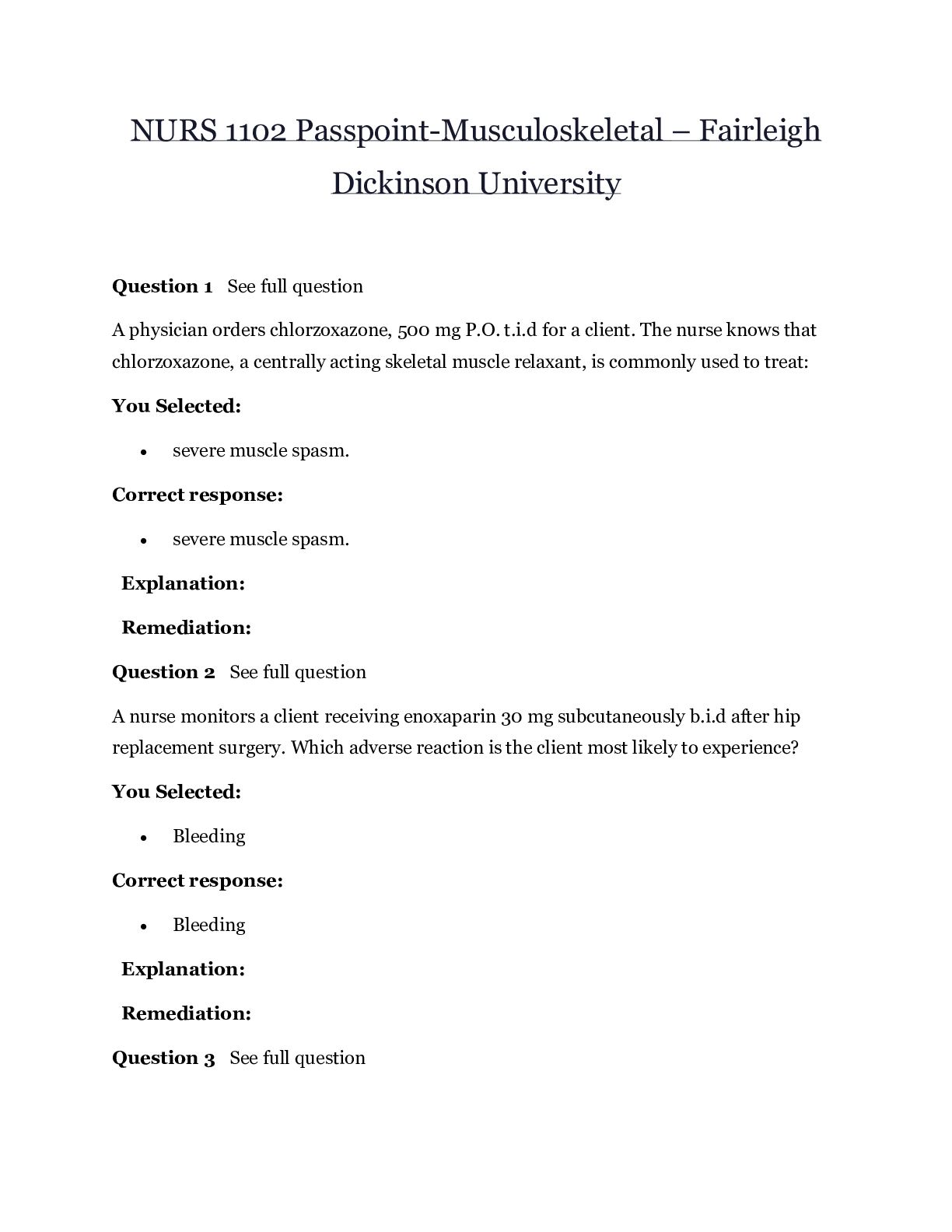
Buy this document to get the full access instantly
Instant Download Access after purchase
Add to cartInstant download
Reviews( 0 )
Document information
Connected school, study & course
About the document
Uploaded On
Aug 15, 2020
Number of pages
152
Written in
Additional information
This document has been written for:
Uploaded
Aug 15, 2020
Downloads
0
Views
58














